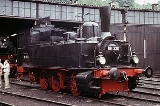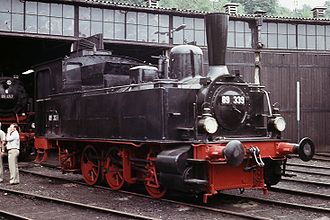
Württemberg T 3
Encyclopedia
| Württemberg T 3 DRG Class 89.3-4 |
||
|---|---|---|
 |
||
| Quantity | 14 | 96 |
| Numbers | DRG 89 301-311 DRG 89 314–316 |
DRG 89 312–313 DRG 89 317–410 |
| Manufacturers | Maschinenfabrik Esslingen Maschinenfabrik Esslingen Maschinenfabrik Esslingen , was a German engineering firm that manufactured locomotives, tramways, railway wagons, roll-blocks, technical equipment for the railways, , bridges, steel structures, pumps and boilers.-Founding:... MG Heilbronn, Krauss Krauss-Maffei The Krauss-Maffei Wegmann GmbH & Co KG or simply Krauss-Maffei is an injection molding machine manufacturer and defence company based in Munich, Germany... |
|
| Entered service | 1891–1896 | 1896–1913 |
| Retired | ||
| Wheel arrangement Whyte notation The Whyte notation for classifying steam locomotives by wheel arrangement was devised by Frederick Methvan Whyte and came into use in the early twentieth century encouraged by an editorial in American Engineer and Railroad Journal... |
0-6-0 | |
| Axle arrangement UIC classification The UIC classification of locomotive axle arrangements describes the wheel arrangement of locomotives, multiple units and trams. It is set out in the International Union of Railways "Leaflet 650 - Standard designation of axle arrangement on locomotives and multiple-unit sets". It is used in much... |
C n2 | |
| Type | Gt 33.10 | Gt 33.12 |
| Average axle load Axle load The axle load of a wheeled vehicle is the total weight felt by the roadway for all wheels connected to a given axle. Viewed another way, it is the fraction of total vehicle weight resting on a given axle... |
10,0 t | 12.0 t |
| Length over buffers Buffer (rail transport) A buffer is a part of the buffers-and-chain coupling system used on the railway systems of many countries, among them most of those in Europe, for attaching railway vehicles to one another.... |
8,505 mm | |
| Driving wheel Driving wheel On a steam locomotive, a driving wheel is a powered wheel which is driven by the locomotive's pistons... diameter |
1,045 mm | |
| Top speed | 45 km/h | |
| Boiler Boiler A boiler is a closed vessel in which water or other fluid is heated. The heated or vaporized fluid exits the boiler for use in various processes or heating applications.-Materials:... overpressure Overpressure The term Overpressure is applied to a pressure difference, relative to a "normal" or "ambient" pressure, in various circumstances:* In engineering: the pressure difference over the wall thickness of a pressure vessel... |
12 kp/cm² | |
| Piston stroke | 540 mm | |
| Cylinder bore | 380 mm | |
| Grate area | 1.00 m² | |
| Evaporative heating area | 63.90 m² | |
| Power | N.K. | |
| Adhesive weight | 29,7 t | 35.7 t |
| Service weight | 29,7 t | 35.7 t |
| Brakes | N.K: | |
The Württemberg T 3s were German steam locomotive
Steam locomotive
A steam locomotive is a railway locomotive that produces its power through a steam engine. These locomotives are fueled by burning some combustible material, usually coal, wood or oil, to produce steam in a boiler, which drives the steam engine...
s with the Royal Württemberg State Railways
Royal Württemberg State Railways
The Royal Württemberg State Railways were the state railways of the Kingdom of Württemberg between 1843 and 1920...
(Königlich Württembergische Staats-Eisenbahnen) delivered between 1891 and 1913.
These tank locomotives were built for hauling goods trains and had three coupled axles but no carrying axles. All 110 examples went into the Deutsche Reichsbahn
Deutsche Reichsbahn-Gesellschaft
The Deutsche Reichsbahn – was the name of the German national railway created from the railways of the individual states of the German Empire following the end of World War I....
fleet where they were incorporated as DRG Class 89.3-4 in the numbering plan
DRG renumbering plan for steam locomotives
In 1922 the Deutsche Reichsbahn began to develop a renumbering plan to standardize the numbering of steam locomotives that had been taken over from the state railways . Its basis was the corresponding DRG classification system....
. By 1945 almost all of them had been retired or transferred to industry.
Three locomotives were rescued from the scrap yard, one of which is being presently restored to operational condition by the Railway Vehicle Preservation Society
Railway Vehicle Preservation Society
The Railway Vehicle Preservation Society is one of the oldest societies in Germany that runs a museum railway...
(Gesellschaft zur Erhaltung von Schienenfahrzeugen).
| Württemberg T 3 L DRG Class 89.4 |
|
|---|---|
| no photograph available | |
| Quantity | 4 |
| Number range | DRG 89 411 |
| Manufacturers | Esslingen Maschinenfabrik Esslingen Maschinenfabrik Esslingen , was a German engineering firm that manufactured locomotives, tramways, railway wagons, roll-blocks, technical equipment for the railways, , bridges, steel structures, pumps and boilers.-Founding:... Heilbronn Krauss Krauss Krauss is a German language surname meaning "curly", and may refer to:* Alison Krauss, an American bluegrass musician* Clemens Krauss, an Austrian conductor... |
| Entered service | 1894 - 1898 |
| Retired | |
| Wheel arrangement Whyte notation The Whyte notation for classifying steam locomotives by wheel arrangement was devised by Frederick Methvan Whyte and came into use in the early twentieth century encouraged by an editorial in American Engineer and Railroad Journal... |
0-6-0 |
| Axle arrangement UIC classification The UIC classification of locomotive axle arrangements describes the wheel arrangement of locomotives, multiple units and trams. It is set out in the International Union of Railways "Leaflet 650 - Standard designation of axle arrangement on locomotives and multiple-unit sets". It is used in much... |
C |
| Average axle load Axle load The axle load of a wheeled vehicle is the total weight felt by the roadway for all wheels connected to a given axle. Viewed another way, it is the fraction of total vehicle weight resting on a given axle... |
10,8 Mp |
| Length over buffers | 8,920 mm |
| Ø Driving wheel Driving wheel On a steam locomotive, a driving wheel is a powered wheel which is driven by the locomotive's pistons... |
1,045 mm |
| Top speed | 45 km/h |
| Boiler Boiler A boiler is a closed vessel in which water or other fluid is heated. The heated or vaporized fluid exits the boiler for use in various processes or heating applications.-Materials:... overpressure Overpressure The term Overpressure is applied to a pressure difference, relative to a "normal" or "ambient" pressure, in various circumstances:* In engineering: the pressure difference over the wall thickness of a pressure vessel... |
12 kp/cm² |
| Piston stroke | 540 mm |
| Cylinder bore | 380 mm |
| Grate area | 1.00 m² |
| Evaporative heating area | 63.90 m² |
| Power | N.K. |
| Adhesive weight Adhesive weight Adhesive weight is the amount of a locomotive's weight that is applied to the driving wheels and so capable of delivering traction. The more weight applied to the driving wheels, the greater the locomotive's ability to haul a load. But if the weight on the driving wheels exceeds the axle load of... |
32.3 Mp |
| Service weight | 32.3 Mp |
| Brakes | N.K. |
The Class T 3 L engines of the Royal Württemberg State Railways
Royal Württemberg State Railways
The Royal Württemberg State Railways were the state railways of the Kingdom of Württemberg between 1843 and 1920...
were also 0-6-0 tank locomotives and intended for goods train duties. Four examples were built, of which one survived into the Deutsche Reichsbahn
Deutsche Reichsbahn
Deutsche Reichsbahn was the name of the following two companies:* Deutsche Reichsbahn, the German Imperial Railways during the Weimar Republic, the Third Reich and the immediate aftermath...
fleet and was numbered as 89 411 within Class 89.3-4 of the DRG renumbering plan
DRG renumbering plan for steam locomotives
In 1922 the Deutsche Reichsbahn began to develop a renumbering plan to standardize the numbering of steam locomotives that had been taken over from the state railways . Its basis was the corresponding DRG classification system....
.
These four 'specials' had a steerable axle and were somewhat longer than the other Württemberg T 3s. They were deployed on the lines from Schiltach
Schiltach
Schiltach is a town in the district of Rottweil, in Baden-Württemberg, Germany. It is situated in the eastern Black Forest, on the river Kinzig, 20 km south of Freudenstadt.-Geography:...
to Schramberg
Schramberg
Schramberg is a town in the district of Rottweil, in Baden-Württemberg, Germany. It is situated in the eastern Black Forest, 25 km northwest of Rottweil. With all its districts Talstadt, Sulgen, Waldmössingen, Heiligenbronn, Schönbronn and Tennenbronn it has about 22,000 inhabitants.One of...
and from Waldenburg
Waldenburg
Waldenburg is the name of several places:* Waldenburg, Saxony, Germany* Waldenburg, Baden-Württemberg* Waldenburg, Switzerland*the former German name for Wałbrzych, Poland* Waldenburg, Arkansas, USAWaldenburg is also a surname:* Louis Waldenburg...
to Künzelsau
Künzelsau
Künzelsau[p] is a town in Baden-Württemberg, in south central Germany. It is the capital of the Hohenlohe district. It is located on the river Kocher, 19 km north of Schwäbisch Hall, and 37 km northeast of Heilbronn....
, but proved to have very high maintenance costs, with the result that three of them were retired by the Württemberg State Railways. The remaining one was taken over by the Reichsbahn, but was soon taken out of service as well.
See also
- Royal Württemberg State RailwaysRoyal Württemberg State RailwaysThe Royal Württemberg State Railways were the state railways of the Kingdom of Württemberg between 1843 and 1920...
- List of Württemberg locomotives and railbuses
External links
- There is a relevant English-language forum at Railways of Germany

